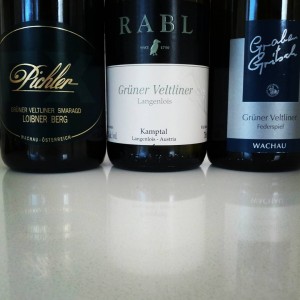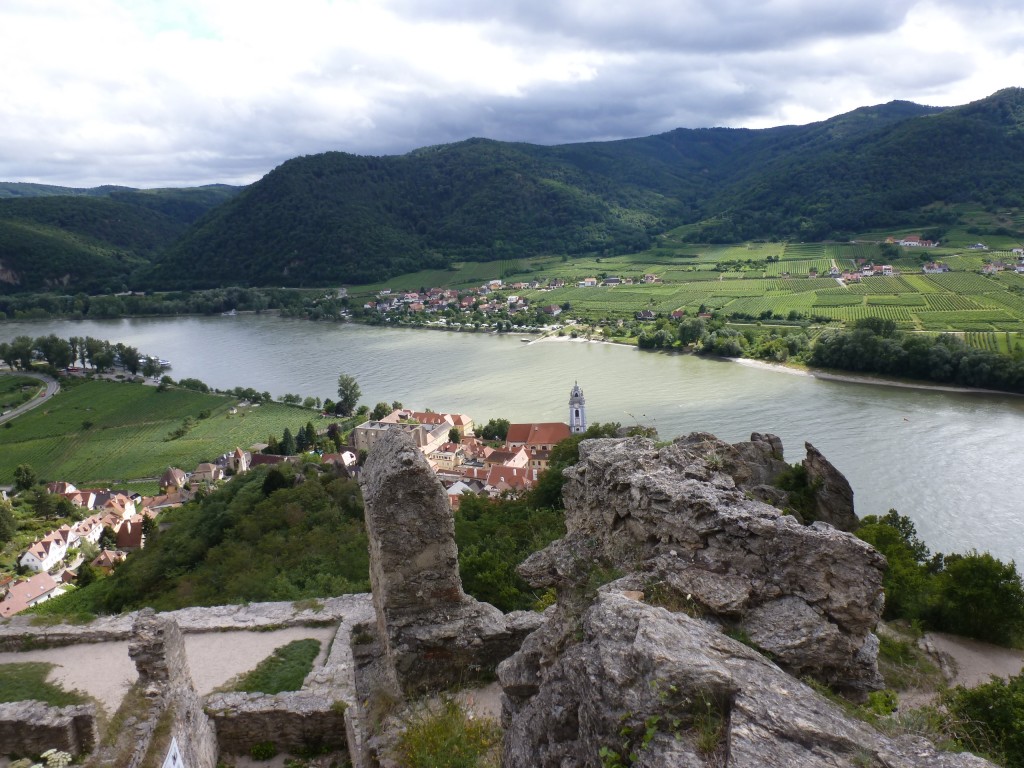Some shameless self-promotion: if the type of information contained in this post interests you at all, I’m going to be hosting a tasting of sparkling wines on Thursday, February 11, as part of Little Brick’s Home School series.
 I’ve been meaning to write about Austrian wine for some time. Years, actually: ever since I wrote this post on Heurigen, which are rural taverns that serve young wine and cider.
I’ve been meaning to write about Austrian wine for some time. Years, actually: ever since I wrote this post on Heurigen, which are rural taverns that serve young wine and cider.
Last week the Elm wine group did a tasting of Grüner Veltliner, the national grape of Austria, so I thought I would finally put down some info on Austrian wine.
If you haven’t had Austrian wine before, you’re not a freak or a philistine: there isn’t a whole lot available in North America. Austria produces almost as much wine as New Zealand[1], but in most generic liquor stores the Kiwis have an entire section, while you would be hard-pressed to find a bottle from Austria. Boutique wine shops like Devine usually carry a handful. It seems that the majority of Austria’s wine is consumed by Austrians.
Despite its relatively small amount of exports, the Austrian wine industry has garnered a lot of attention in recent years because of its commitment to both its regional identity and quality production. The latter sounds like it should be a given, but within most wine-producing countries there are regions that make enormous quantities of mediocre or bad wine, creating surplus, driving down prices, and ultimately threatening the entire wine industry.[2] The southern-most regions of France and Italy are infamous examples. By contrast, almost all of the area under vine in Austria is devoted to quality wine production. Austria also has some of the most stringent regulations for processing and labelling, though admittedly these were put into effect after a 1985 scandal that saw some producers adding diethylene glycol to improve the body of their wines.
It’s always tempting to lump Austria in with Germany, and while the two countries do share some grape varietals and labeling practices, Austrian wines have a lot more in common with those of Alsace than Germany. They produce mainly dry whites, common varietals being Grüner Veltliner, Welschriesling, Riesling (almost always dry, unlike German examples), and Gewürztraminer (also dry, unlike Alsatian examples). The most common red variety is Zweigelt, an Austrian native. As in Germany, wines are sold under varietal name.
Austrian wine production occurs almost entirely in the east end of the country, in the lower regions away from the Alps of the west. Most of the Austrian wines available to us in North American come from the province of Lower Austria (Niederösterreich), specifically parts of the Danube and its tributaries just upstream of Vienna: Wachau, Kremstal, Kamptal, and Traisental. (The suffix “tal” indicates a valley. The Kremstal is the valley around the town of Krems. The Kamptal is the valley formed by the river Kamp.) The most important of these is the Wachau.
Wachau. The Wachau is a stretch of the Danube west of Vienna. Much like the German Mosel, the best wines here are labelled by varietal as well as the vineyard or hill that produced the grapes. Important hills include Loibenberg, Terrassen, and Kellerberg. These may appear on labels either by themselves, or in conjunction with the name of the adjacent village (eg. Dürnsteiner Kellerberg refers to the hill Kellerberg by the town of Dürnstein).
The Wachau also has its own version of the German “predicate” labelling system, which classifies wines by pre-fermentation must weight, that is, sugar content. The more concentrated the original must, the higher potential alcohol, and in theory the higher the quality of the wine. So in Germany Rieslings are classified as Kabinett, Spätlese, Auslese, Beerenasulese, and Trockenbeerenauslese, in order of increasing must weight (and by extension increasing prestige and price-point…)
The Wachau sytem is much simpler, and uses final alcohol content instead of original must weight. The lightest grade is Steinfeder (named for a type of frizzy grass) which is below 11.5% ABV. Next is Federspiel (named for a bird) between 11.5 and 12.5%. The highest quality wines are labelled Smaragd (a kind of small lizard native to the region) and are above 12.5% ABV.

Grüner Veltliner, the most commonly planted grape in Austria, has become a darling of the wine cogniscenti in recent years. Here’s what rockstar sommelier Rajat Parr has to say about the varietal…
A robust white, it features some of the greenish flavors of Sauvignon Blanc and a hint of legumes, making it the perfect match for green vegetables like peas, asparagus, artichokes, and lettuces. (Secrets of the Sommeliers[3], page 208)
[Grüner Veltliner] has a beany, green, peppery character that nicely offsets asparagus… (ibid, page 115)
It’s ridiculous for me to try and contradict Rajat Parr, but I’ve never, ever picked up “green” aromas from Grüner (despite its name… which I think means “green grape from Valtellina”, but that refers to the colour of the fruit itself, not it’s aromas). I’ve always struggled to pick up that smell, even in Sauvignon Blanc, so I should just keep my mouth closed.
Getting back to the original point of this post, for our Grüner Veltliner tasting we tried three examples. Some quick notes follow.
F.X. Pichler 2007 Loibner Berg Smaragd Grüner Veltliner. Pichler is one of the big family names in the Wachau. The wine smelled exactly like an old pineapple, and had a viscous mouthfeel. If the tasting had been blind I would have sworn it was a New World oaked Chardonnay. It was almost unanimously the favourite of the three wines we tasted, until it was revealed that it was $49.99 at Wine and Beyond. With that price tag it is not likely be purchased by anyone in the group.
The next day I happened to read this: “Because Wachau’s producers have the ability to push the ripeness envelope, they are tempted to overdo it, as is happening in Germany’s Rheingau. A few well-known producers have fallen into this trap – F.X. Pichler and Hirtzberger to name two – and for the privilege of drinking their unbalanced wines, you pay a costly premium. Stick to the better, more proportional wines of Prager, Altzinger, and Knoll.” (ibid, page 115)
Rabl 2014 Grüner Veltliner Langenlois. This is an interesting one. Basically no fruit on the nose. Strong, frankly peculiar aromas that I described as rice cake, toast, and mock orange blossom. (The tasting notes posted at the place of purchase said, “citrus notes with a dusting of stony mineral”. Go figure.) It has a sharp, bright acidity, and the flavour of lemon pith. Quite distinctive. The Rabl was $21.99 at Devine.
Gritsch 2013 Steinterrassen Federspiel Grüner Veltliner. The lightest of the bunch. A nose of wet stone and red apple. Medium, round, happy acidity. Short finish. $22.99 at Devine.
#ButtonSoupCellar is a series of posts about wines and spirits
Footnotes
- New Zealand and Austria are 17th and 16th, respectively on this list.
- The Oxford Companion to Wine says that surplus production is “the single greatest problem facing the world’s wine industry”.
- Secrets of the Sommeliers by Rajat Parr and Jordan MacKay. Published by Ten Speed Press.